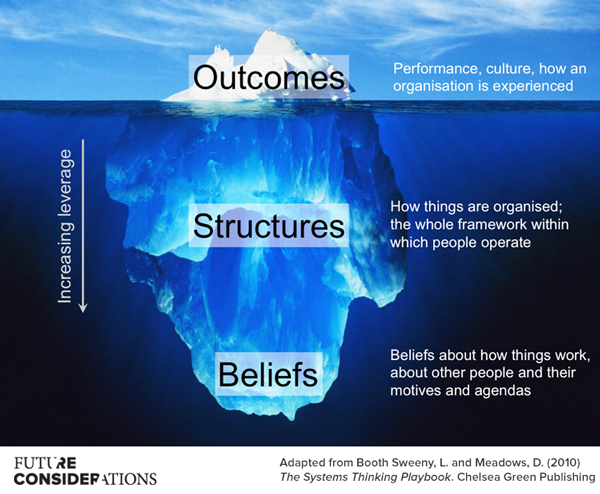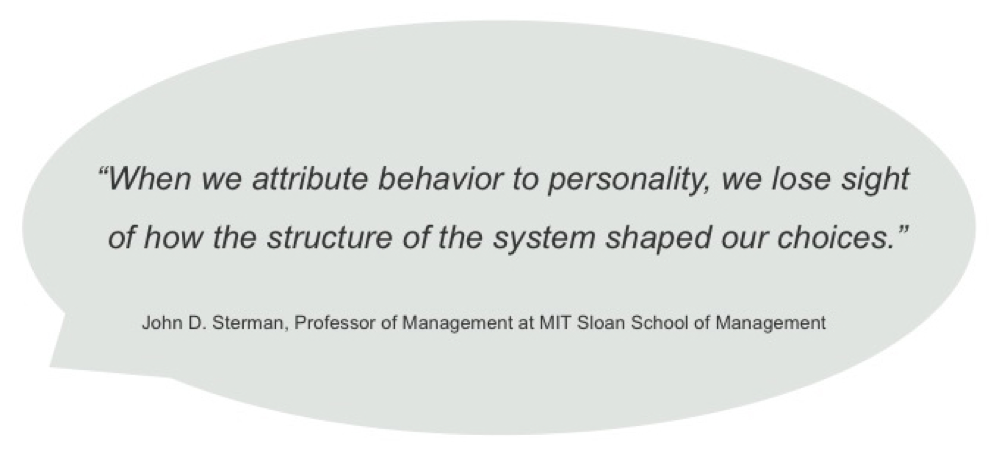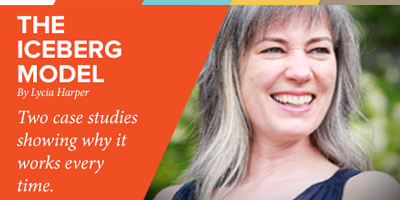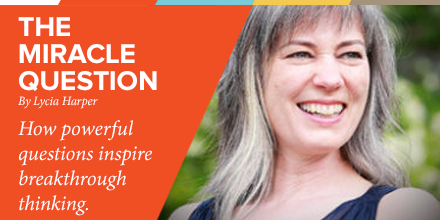Involved in transformation? People love the iceberg model!
I had the experience again. I offered a simple iceberg model and my client seized on it, waved it around and started using phrases like “going deeper in the iceberg”. It happens every time I share it; people love it.

You might not love this model if you’re a purist about complexity science or a stickler for precision. You might balk at its simplicity and the things it omits. You might find it wonderful and marvel at how it helps people shift to a more systemic way of looking at things.
The iceberg model and why people seem to love it
There are many versions of the iceberg model. The original for this one came from The Systems Thinking Playbook by Linda Booth Sweeney and Dennis Meadows (thanks and respect – it’s a brilliant book). I have adapted it as I’ve used it with people.
This model is a very simple representation of a complex system. It uses the metaphor of an iceberg to illustrate that our experiences are deeply influenced by dynamics we cannot easily see: the structures that form the framework within which we operate, and the beliefs we hold about how things work.
It’s simple and easy to understand and seems to be at a ‘Mummy Bear’, medium level of abstraction – not so specific that it’s scary and not so vague that it loses all meaning.
Its great strength seems to be that it puts the client in the driving seat in a conversation about the interventions to try in their organisation. A light goes on for people when they see the list of structures, the ‘levers’ they can pull. It often triggers new insight about what they’re experiencing and new ideas for how to intervene.
“Where do we have permission, agency and appetite to experiment?”
The conversation often starts with structures and flows into beliefs, and a richer picture emerges.

Case study A: finding the place to intervene in an arts organisation
This example comes from a transformation project I ran for an arts organisation. One of the ‘hot’ presenting issues was the pickle they were in with their creative meetings. “People weren’t talking and the meetings weren’t functional. Our work is creative, about emotion and passion, but people were detached; I was flummoxed as to why people weren’t contributing,” said the meeting owner.
Some of the hidden dynamics were around the power structures underpinning the ideas process: whose ideas were taken seriously and the process by which ideas came to life. It pointed to some organisational beliefs about creativity and the hierarchies that existed but neither of these were safe topics for discussion at the time. We could however talk about their structures such as their processes of communication and collaboration.
A shift happened after a systems game when I used the iceberg model to help them make sense of their experiences and open up a conversation about the experiments they could run in their organisation. They wanted to put their energy into something that felt exciting and began talking about a new area in their building how they could set it up as a hot-desking space.
It proved to be a key intervention. People from other departments began to mix with ‘the ideas people’ and take part in the informal conversations leading up to the creative meetings. The conversations shifted and the old beliefs about who was qualified to develop ideas began to dissolve – without us having to address them directly. There were other dynamics and interventions but the hot-desking space was an important catalyst for change. It seemed to unlock enough for people to begin to experiment in other areas.
“You can’t underestimate the incredible difference moving offices made, and it already feels different, with a focus on conversation rather than email.”
“Creative team meetings have a new lease of life. They aren’t about putting ideas into practice any more; they’re about practising being creative together. We’re changing the format every time and asking who wants to get involved from the whole of the organisation.”
“There’s a new mindset; we understand things differently.”
Case study B: Be careful what you measure
There’s another aspect to this: using the iceberg model to remind ourselves about the influence the structures and beliefs can have on behaviours – and how creative people can be in delivering exactly what you ask for.

A very large, global organisation wanted to increase ‘employee engagement’ in community investment across their offices around the world. ‘Engagement’ was defined as ‘the number of employees participating’ across a of programmes and a high target was set.
The retail guys rolled up their sleeves, delivered some amazing projects, raised a record-breaking amount of money for charity and moved the dial on brand loyalty with some great local PR. Employee satisfaction moved up a notch with community participation cited as one of the top 3 reasons to work for their part of the organisation. They did a great job – but missed the participation target.
The finance guys took a different approach. Their manager heavily promoted payroll giving where employees could donate the ‘pennies’ from their salary – so each person would donate between 1-99p (or cents) each month. They raised relatively little money and people didn’t have the experience of participating in anything so it didn’t affect employee satisfaction or the brand. They did however completely blast the target, the only part of the organisation to do so.
It won’t go down as a great example of employee engagement, but was a lovely lesson in how influential measurement is.
Have you ever used the Iceberg model before with your team? What type of impact did it have and how did it shift the conversation? Add your experience working with the Iceberg Model to the comments area below:
===
I (Lycia) help people think and act systemically based on the science of how complex systems work and evolve. Click here to get in touch.
Originally posted on LinkedIn, 10 Oct 2017.



i have not used the model however, i would like to employ it to develop a model on Literacy.
may the Tree Iceberg Model be ideal to explain literacy as dynamic. usually different groups of people on view the trees branches and not roots same as literacy where people mostly view it as acquisition of basically reading and writing. but, it is more than that. help me develop the iceberg model for literacy borrowing from the cultural iceberg model.
Hi Chibale,
What a great vision you have to combine these two ideas! We haven’t yet explored the idea of developing the framework any further, however, we are running a workshop to help more people experience the Iceberg model for themselves. Perhaps you would like to be involved? Click here to request an invitation to attend the workshop.
Cheers,
Pete
In our orgernisation we went to a hard to reach area to distribute male condoms to out of schools youths for them to prevent themselves from unintended pregnancies, HIV/AIDS and Sexual transmitted infections. When we engaged the youths to our surprise most of the youths refused to receive condoms. There after we used the iceberg model to know the reason why they were refusing condoms and we find out that using condoms during Sexual intercourse is not accepted according to their cultural beliefs. Then we thought of starting with community sensitization on the negative effects of harmful cultural beliefs and importance of safe sex, it works, thereafter we distributed male condoms to over 500 youths. After some months we find out out that number of unwanted pregnancies and Sexual Transmitted Infections cases were low among youths.
So Here is a Ice Berge Model.
So my team and I decided to distribute some disposable sanitary pads to girls in vulnerable communities and trying to put an end to period poverty but unfortunately the girls always complained that the pads did not sustain them as they attend monthly. So the team had to be strategic and critically find loop holes.
After critically analyzing and doing a survey, it was found out that what was convenient and more sustainable was using reusable sanitary pads but what was even more amazing is how many problems it solved. If you carry out the training on making reusable sanitary pads, you offer skills which girls can be use to make some money. So the girls not only have pads but can also reuse and knowledge on entrepreneurship which empowers them and keeps them busy thereby reducing the dependency and peer pressure rates.
This was very helpful.
We have a project where we are promoting girl child education through providing psycho-social support in school going girls’ clubs. We realized that most of the girls did not attend our club sessions then we applied the iceberg model to find out why it is so. Then we realized that there were misconceptions about the club that the clubs were for girls who do not do well in class. Then we engaged in sensitizations mostly in schools to make the students understand the purpose of the clubs and later the attendance normalized.